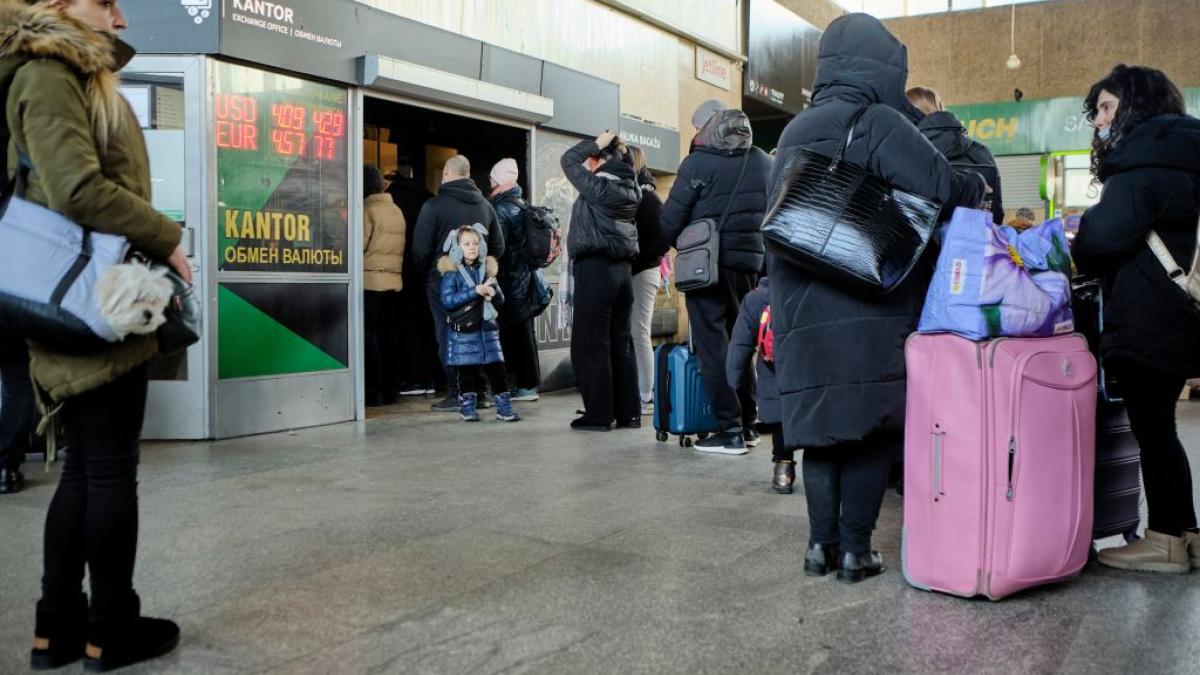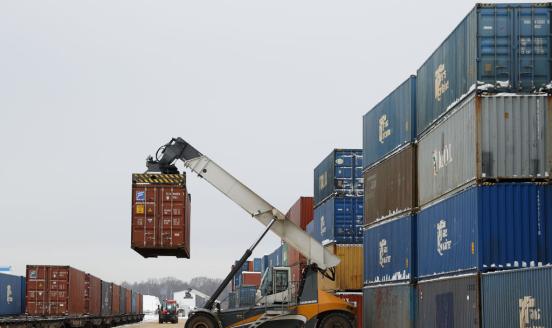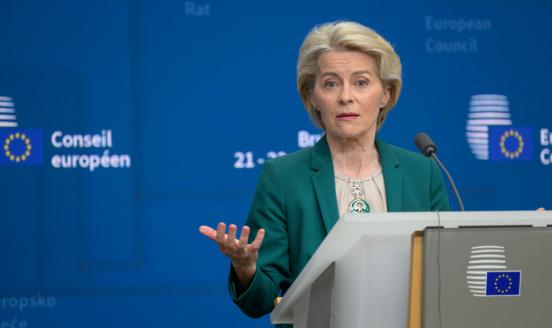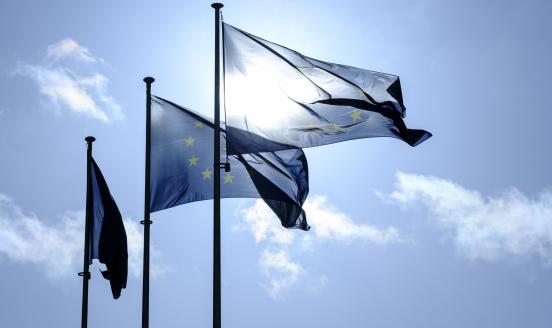The economic policy consequences of the war
Whatever the duration of the war, its legacy will be long-lasting. It will shape Europe’s policy choices for the years and decades to come.

The European Union has responded to the war at its Eastern border with exceptional unity, resolve and speed. But the invasion of Ukraine is a watershed. Whatever the duration of the war, its legacy will be long-lasting. It will shape Europe’s policy choices for the years and decades to come.
This blog post aims at providing a first assessment of the economic policy consequences of the invasion and the decisions taken since 24 February, when Russian troops entered Ukraine. The main immediate risks to the European economy arise from the supply shock triggered by the increase in oil and gas prices, from Europe’s dependence on Russian energy and from the impact of geopolitical threats on household confidence and investors’ sentiment. Europe also has the duty to welcome millions of war refugees and provide them with emergency assistance. In 2022 already, the direct budgetary impact of the corresponding decisions could amount to 1.1/4% of GDP, if not more. Longer-term, the EU is confronted with the need to boost defence spending in response to aggravated security threats and to rethink its energy system.
The upshot is that policymakers in Europe must pivot away from the expected post-COVID-19 normalisation and to join forces to tackle new emergencies. Longer term, they face a wholesale rethink of the EU policy system, which will affect budgetary priorities, principles for macroeconomic policies and market regulation and the division of tasks between the EU and its member states.
For the purposes of this blog post, many other channels, from the confidence shock to ripple effects on agricultural supplies and commodities markets, are left aside. I do not address either the broader, and critical, question of the potential fragmentation of the global economy that could result from the realisation that the ‘weaponisation of interdependence’ is no longer a matter for mere speculation.
Orders of magnitude provided in this blog post are extremely rough. They may prove wrong by a significant margin. The aim here is only to contribute to a discussion that must develop and will certainly result in much more accurate assessments.
1. Responding to a new supply shock
On the eve of the attack on Ukraine, the EU was already coping with a sharp deterioration of its terms of trade and with rising inflation, most of which was attributable to the price of imported energy. Although recovery from the pandemic shock is still incomplete and inflationary expectations are still somewhat below target, the European Central Bank was facing a difficult balancing act between looking through temporary price hikes and addressing the inflationary threats. The confrontation with Russia implies a more pronounced and longer-lasting shock, which will seriously aggravate the prevailing policy dilemma.
The standard rulebook when facing a commodity price shock is that the central bank should essentially tackle the second-round effects and avoid a potential escalation of inflationary expectations. It should not embark on a futile attempt to control the immediate impact of price rises on aggregate inflation (on which increases in the policy rate have very limited bearing, if any), and it should accommodate permanent relative price changes.
In the very short term, the ECB is likely to wait and see until it takes a decision. But it may soon be forced to make a politically difficult choice between tolerating headline inflation remaining above target for longer, and weakening the economy in the midst of a geopolitical confrontation. Its action will be further complicated by the risk that the spreads on government bond markets might widen.
As argued by Olivier Blanchard, in this situation a case can be made for a partial fiscal offset of the shock. In most EU countries, initiatives have been taken already. Governments have introduced a raft of measures to contain the rise in prices and to support vulnerable households.
But the question is whether governments should rely primarily on transfers (which can be targeted but do not contribute to limiting inflation) or should also intervene through across-the-board tax cuts and administered price controls (which affect the consumer price index and therefore facilitate the task of the central bank, but are much more costly budget-wise and obliterate the price signal). In some EU countries at least, both types of measures are being implemented.
The war context will push governments toward implementing more direct price interventions than they would normally consider. An important issue is whether the EU will revise the mechanism that leads to electricity being priced on the basis of the cost of the marginal energy source, which acts as a powerful transmitter of shocks to the price of gas and creates massive rents for electricity producers. Some governments, for example in Spain, have introduced clawbacks. Others, like in France, have capped price rises. Whatever the discussion on the intrinsic merits of the electricity-pricing system in place in the EU, there is now a case for a rethink in a context in which inflation acceleration is a major concern. Unplugging this mechanism temporarily (for, say, six months) would alleviate pressing macroeconomic policy trade-offs.
More generally, the war will inevitably lead the EU and national states to depart from standard policy assignments. It will prompt further steps into a messy world in which governments interfere with markets for security reasons and in which monetary and fiscal policy are strongly interdependent. Coordination, rather than the clarity of the policy framework, will be the new motto. The COVID-19 crisis has already resulted in a move in this direction. Hopes for normalisation are most likely to be frustrated.
Fiscal support has and will have a significant impact on public finances. Measures introduced since summer 2021 already entail a non-trivial budgetary cost (0.5% to 1% of GDP in France, where the president is admittedly facing re-election). New measures in response to elevated energy prices could increase this cost further, perhaps to 1% of GDP.
2. Reducing energy reliance on Russia
Continued reliance on energy imports from Russia is in contradiction with the strategy of cutting off the aggressor from international finance and payments. At prices somewhat below current levels ($100/bl for the Brent and €100/MWh for the gas), oil and gas quantities exported by Russia to the EU in 2019 would be valued about €200bn each, in total roughly twice as much as foreign exchange reserves held in G7 countries at end-2021. It is imperative to curtail this income stream.
What would be the point of preventing the Bank of Russia from accessing its reserves if Russia continues to benefit from much-inflated export income? Energy carve-outs actually protect the largest part of the Russian banking system from being excluded from SWIFT. All in all, record export income flows are currently entering Russia despite the discount on the price of oil it sells abroad.
Russia is the EU’s main supplier of oil (27% of imports, 2019 data), coal (47%) and gas (41%). Oil and coal do not require special infrastructure to be delivered to the market. They can be put on a boat and shipped to wherever there is a buyer. Gas, however, is critical because trade depends on infrastructure, meaning that neither the supplier nor the buyer can diversify seamlessly.
A global ban on Russian oil imports is being discussed. The question is whether an effective curtailment of Russian sales would result in the price ratcheting up on the global market, which would add to the global supply shock and possibly frustrate the sanctioning effect of the measures taken. A ban can only succeed if cuts in Russian shipments are offset by supplementary exports from other producers.
For gas, Europe and Russia are set to play a game of chicken over their mutual dependency. Russia certainly has leverage. If it were to discontinue exports, the EU would lose 40% of its natural gas supplies. The impact on some EU countries would be catastrophic. This is why Brussels has so far left gas outside the scope of sanctions. But the EU has two assets: Russian gas imports represent only 8.4% of its total demand for primary energy, and it has more capacity to diversify its sourcing than Russia has to diversify its exports markets. Anyhow the EU must prepare to manage without Russian gas, because not planning for such an occurrence would expose it to Russian blackmail.
Shipments from Russia to the EU amounted to 1800 terawatt hours (TWh) in 2019 (2020 and 2021 were abnormal years), out of a total of 3800 TWh of natural gas imports. But the EU also needs to replenish its reserves, which are running very low. Even if it cuts overall gas consumption by one-fifth and limits the replenishment of reserves to 500 TWh, it will need to import some 3400 TWh in 2022. If gas stops flowing from Russia (either at EU or Russian initiative), imports from other sources would have to increase by 35%.
Replacing Russian gas is feasible but hard (as the IEA and Bruegel have shown). To start with, it is bound to be costly in the short run, especially if – as for oil – cutting off the leading gas exporter from the global market results in further price escalation. For an EU ban on imports from Russia to be effective, it would need to be designed in a way that takes into account spillbacks onto the global market. Put differently, Europe would need to reduce its demand for imports by increasing the supply from other sources (by delaying the closure of coal and nuclear plants and ramping up the deployment of renewables, for example) and by cutting domestic demand for gas (through dual pricing schemes for domestic heating) and other fuels (possibly through limiting speed on highways).
Assuming a halving of Russian gas supply and a 50% cost increase for new shipments by non-Russian suppliers, the extra bill would be €25 billion in 2022. Total gas imports would amount to €370 billion against €60 billion in 2019 and €170 billion in 2021.
The next difficulty has to do with intra-EU logistics. The impact of the shock will be very unevenly distributed: Portugal does not import any Russian gas, whereas its share in total primary resources is 35% for Hungary and 24% for Slovakia. The potential for enhancing LNG terminals is also unequally distributed (Spain has significant capacity, landlocked countries have none), while interconnections are patchy (there is not a European gas pipelines system to speak of). Emergency remedial action will therefore be needed to enhance existing facilities, organise immediate supplies and launch emergency investments. It is hard to put a number on these initiatives. Assuming they would also increase the cost for the end user by 50%, the price tag would be another €25 billion.
On this basis the short-term cost of reducing energy dependence on Russia could amount to €100 billion (€50 billion to rebuild reserves plus €25 billion extra cost of non-Russian supplies plus €25 billion to organise distribution within the EU). The questions then are: first, how much of it would be borne by private companies and end-users, and how much would have to be borne by public finances; second, how should this cost be shared between individual member states and the EU?
In an emergency situation, when security is at stake and against the background of heightened risk aversion, governments will step in to direct responses to shortages, threats and risks, and it is prudent to assume that the financing burden will fall disproportionately on public finances. Private companies are neither in charge of security of supply, nor of making sure that all households have access to heating.
Even part of the building up of reserves, normally a purely private task, will need to be publicly financed: private companies will be reluctant to shoulder the cost of replenishing reserves (€50 billion), because they would risk losing considerable amounts of money if the price of gas normalises. It is therefore reasonable to assume that taxpayers’ money will need to bear three-quarters of the cost, or €75 billion.
Part of this burden will need to be shared within the EU despite the fact that, while it is true that dependency on Russian gas is a legacy for central and eastern Europe, for Germany or Italy it is the product of a deliberate choice. But to reject solidarity in the name of moral hazard would be far-fetched. After the euro crisis shock and the COVID-19 shock, the fallout from the economic confrontation with Russia is yet another, hardly predictable, asymmetric shock. Cost-sharing is called for, as it was for the COVID-19 crisis. Tight coordination is also called for, unlike what happened in response to the pandemic.
In the medium term, the EU will have to design and finance a wholesale rebuilding of the European energy system that will include the diversification of supply sources, stronger interconnection and the definition of contingency plans for responding to supply disruptions. In so doing, it will need to give significantly more weight to its security objective than in the initial design of the electricity market. Because of a pervasive lack of trust among EU countries, collective energy security was for a long time a topic for speeches rather than for action. The time has come to rethink and build an efficient and secure energy system that makes the best of comparative advantage and treats energy security as a club good. This will require significant investment.
For the immediate future, the upshot is that, whereas the EU cannot realistically dispense with Russian gas altogether, it can immediately prepare to lower its reliance on it, invest in diversification and commit to a stepwise reduction of its imports (as done in the past with Iran). This policy is bound to entail a significant short-term economic cost, but it is the condition for winning the game of chicken with Russia.
3. Tackling the refugee crisis
The refugee crisis is developing fast. In only ten days, nearly two million people have arrived in Poland and other central and eastern European countries. The number will rise further. The long-term cost of welcoming refugees is likely to be negligible, as they may either return to their home country or quickly integrate into the European labour market. But in the short term, they need food, accommodation, healthcare and education for children.
Estimates of the corresponding cost, for example by the UNHCR, are relatively low. Experience shows, however, that costs can quickly mount: in Germany budgetary expenditures on refugees reached €9 billion in 2016, for about 750,000 applicants. If allowances are put at €10 billion per million refugees per year, the cost could easily reach €30 billion in 2022. This cost cannot be borne by the host countries, which are relatively less developed. It will need to be mutualised, mostly through the EU budget and additionally by international agencies such as the UNHCR, as well as charities.
4. Engineering a surge in defence expenditures
The EU has already unlocked immediate support to the Ukraine, with a first €500 million military assistance package (to which bilateral aid should be added). More is likely to be needed in the coming weeks, even if the war ends soon.
Much more importantly from an economic standpoint, Germany has committed to an increase in its defence budget, first through the setting up of a €100 billion debt-financed fund (close to 3% of GDP) and more lastingly through a tax-financed increase in defence spending from 1.4% to 2% of GDP. Other EU countries, with defence budgets close to 1.5% of GDP on average, are in similar situations and are likely to follow suit. France is an exception with 2.1% of GDP already. But this includes the cost of nuclear forces. France also will need to increase the budget for conventional forces.
Assuming no direct military involvement in the conflict in Ukraine but a gradual ramping up of the defence effort, additional military spending in the EU could easily reach €20 billion in 2022 and twice as much in 2023. The cost will certainly be higher in the medium term. The likely minimum increase in defence spending should be 0.5% of GDP or €70 billion, from 2024-2025 onwards. Significantly more is a distinct possibility: in many European countries, the defence budget represented about 3% of GDP in the 1980s. It remains to be decided which part of this surge will be financed by taxes, and which by debt.
As things stand, most of this cost will be borne by national budgets, but the EU will also need to step in, at least for the financing of research and development programmes. Potentially stronger involvement of EU public finances will depend on political decisions on whether and how to establish a common European defence policy.
5. A significant transformation and a major budgetary impact
In response to an acute security crisis, the EU and its constituent member state now need to:
- Alleviate the price and income consequences of a new and major supply shock;
- Start reducing imports of Russian gas, while rebuilding inventories for next winter;
- Launch an emergency energy resilience plan to increase non-Russian energy supplies and distribute them within the Union;
- Integrate energy systems much more strongly and build a collective energy security doctrine;
- Mutualise the cost of welcoming refugees from Ukraine;
- Ramp up defence spending and lay the foundations for a common defence policy.
These tasks only are only part of a major endeavour that will test the capacity of Europe to act swiftly and decisively, but also to embark on the provision of new public goods it previously had no responsibility for, and to organise solidarity. The medium-term implications are also of a first order. So far, the expectation in the EU was that decarbonisation, digitalisation and resilience investments would dominate the medium-term agenda. Security – both economic and defence security – is now added to this agenda.
A rough, back-of-the-envelope assessment of the corresponding short-term direct budgetary cost for the EU and its members could sum up to:
- An additional €50 billion to contain the domestic price consequences of an aggravated supply shock;
- €75 billion on energy independence;
- €30 billion on refugees and humanitarian assistance;
- €20 billion on security and defence in 2022, and twice as much in 2023.
All in all, total discretionary spending and tax cuts could represent €175 billion or about 1.1/4% of GDP in 2022. Further expenditures are called for in the medium term, especially on energy security and defence. They could represent at least half a percent of GDP per year.
Part of the burden will fall on the member states (especially for price interventions, targeted transfers and defence). Together with the adverse macroeconomic shock, these additional costs will disturb the structural consolidation planned for 2023 and beyond. In its 2 March fiscal policy guidance, the European Commission remained cautious. The EU will certainly need to postpone the de-activation of the general escape clause of the Stability and Growth Pact that was initially envisioned for 2023.
At the same time, the adverse shock, heightened risk aversion and a discount on European assets are likely to aggravate public debt-sustainability concerns in the most fragile member states. The EU’s fiscal framework – and national frameworks, such as the German Schuldenbremse – must be made flexible enough to make room for new priorities, but the need for fiscal responsibility is more acute than it has ever been.
The challenge is also significant for the ECB. It will need to avoid tightening prematurely, but also retain flexibility in the allocation of asset purchases, if it wants to prevent a widening of sovereign spreads.
Part of the new programmes – especially for the refugees and the redesign of the energy system, and probably in part for defence also – will need to be administered and financed by the EU, for which they will represent a significant addition to its current role and budget. Existing vehicles, including the Next Generation EU package adopted in response to the COVID-19 shock, offer some immediate flexibility to reallocate funds. A new EU budget that should put much more emphasis on European public goods, and a new off-budget package to finance the pressing ramping up of energy security, humanitarian assistance and joint defence expenditures, may soon be indispensable. The experience with Next Generation EU (NGEU), the off-budget scheme launched in 2020 in response to the COVID-19 crisis, provides a basis for designing the latter, though it will most probably be less redistributive.
Europe is facing a rethink of its Weltanschaung, its priorities and its policy framework. Jean Monnet famously wrote that “Europe will be forged in crises and will be the sum of the solutions adopted for those crises”. We now understand that his prediction should be read literally.
I am grateful to all colleagues, especially from Bruegel and PIIE, who provided feedback on an earlier version of this article. Many thanks to Thomas Belaich for painfully thorough research assistance. The usual disclaimer strongly applies: all errors are mine only.
Recommended citation:
Pisani-Ferry, J. (2022) The economic policy consequences of the war, Bruegel Blog, 8 March
Appendix: Technical assumptions for the gas market
The table below details the assumptions made in the text on the gas market balances. Data for 2019 serve as bases for hypothetical 2022 projections.



